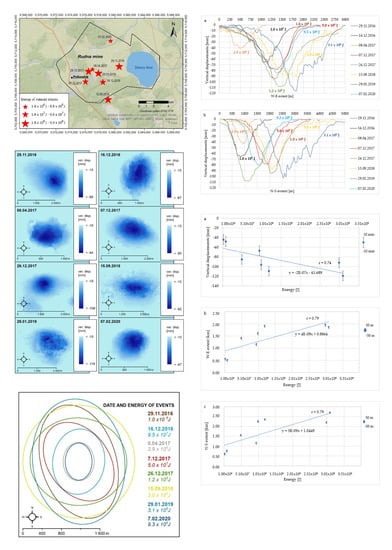Application of DInSAR and Spatial Statistics Methods in Analysis of Surface Displacements Caused by Induced Tremors
Abstract
1. Introduction
2. State of Knowledge
3. Study Area
3.1. Geology and Tectonics
3.2. Mining Operation
3.3. Induced Seismicity
4. Materials and Methods
- is incidence angle;
- is horizontal north–south of look vector;
- is horizontal east–west of look vector;
- is vertical up–down of look vector.
- is the vertical displacement;
- is the LOS displacement;
- is the incidence angle.
5. Results
6. Discussion
7. Conclusions
- The Sentinel-1 A/B mission ensures sufficient frequency of delivering new satellite imagery to detect terrain displacements due to induced seismicity in the area of underground copper mining.
- The DInSAR method enables the determination of displacements caused by induced shocks with energy from 2.9 × 106 J to 3.1 × 108 J (magnitude from 2.71 to 3.75).
- The greatest number of interferograms was calculated for the winter months of: November December, February, while the smallest number in January, April, and September. Low coherence for these months was due to the area being covered with dense vegetation or snow.
- GIS provides tools facilitating further processing, as well as analysis of the results and their visualization. The use of spatial statistics made it possible to develop the characteristics of the geometry of the resulting troughs.
- The deepest trough was created after the shock of 29 January 2019 (energy 3.1 × 108 J) with mean maximum vertical displacement equal to −119 mm. The shallowest trough was caused by the shock of 8 April 2017 (energy 2.9 × 106 J) with an mean maximum vertical displacement of −44 mm. The mean values of the spatial ranges of these troughs ranged from 500 m and 1950 m in the W–E direction and from 600 m to 2700 m in the N–S direction.
- Strong positive relationship has been determined between energy of induced shocks and the resulting vertical displacements of terrain, as well as between energy and spatial extents of deformation areas. The highest value of the coefficient of Pearson (r = 0.79) was determined for the energy vs. W–E extent and N–S extent relationship while the lowest (r = 0.76) for energy vs. mean maximum vertical displacements.
Author Contributions
Funding
Acknowledgments
Conflicts of Interest
Appendix A
| Name of Satellite Imagery | Direction of Track | Number of Track | Temporal Baseline | Sub-Swath |
|---|---|---|---|---|
| 29 November 2016 | ||||
| S1A_IW_SLC__1SDV_20161128T164319_20161128T164346_014145_016D6F_F88D S1B_IW_SLC__1SDV_20161204T164255_20161204T164323_003249_005891_D8C7 | A | 73 | 6 | IW2 |
| S1A_IW_SLC__1SDV_20161128T164319_20161128T164346_014145_016D6F_F88D S1A_IW_SLC__1SDV_20161210T164319_20161210T164346_014320_0172FE_EAEB | A | 73 | 12 | IW2 |
| S1A_IW_SLC__1SDV_20161128T164319_20161128T164346_014145_016D6F_F88D S1B_IW_SLC__1SDV_20161216T164255_20161216T164323_003424_005D95_4152 | A | 73 | 18 | IW2 |
| S1B_IW_SLC__1SDV_20161119T050802_20161119T050832_003023_005239_697D S1A_IW_SLC__1SDV_20161207T050847_20161207T050914_014269_017152_805A | D | 22 | 18 | IW2 |
| S1A_IW_SLC__1SDV_20161128T164319_20161128T164346_014145_016D6F_F88D S1A_IW_SLC__1SDV_20161222T164318_20161222T164345_014495_017872_496C | A | 73 | 24 | IW2 |
| 16 December 2016 | ||||
| S1B_IW_SLC__1SDV_20161216T164255_20161216T164323_003424_005D95_4152 S1A_IW_SLC__1SDV_20161222T164318_20161222T164345_014495_017872_496C | A | 73 | 6 | IW2 |
| S1B_IW_SLC__1SDV_20161204T164255_20161204T164323_003249_005891_D8C7 S1A_IW_SLC__1SDV_20161222T164318_20161222T164345_014495_017872_496C | A | 73 | 18 | IW2 |
| S1B_IW_SLC__1SDV_20161213T050801_20161213T050831_003373_005C25_7299 S1A_IW_SLC__1SDV_20161219T050847_20161219T050914_014444_0176D0_EF54 | D | 22 | 6 | IW2 |
| S1A_IW_SLC__1SDV_20161207T050847_20161207T050914_014269_017152_805A S1A_IW_SLC__1SDV_20161219T050847_20161219T050914_014444_0176D0_EF54 | D | 22 | 12 | IW2 |
| 8 April 2017 | ||||
| S1A_IW_SLC__1SDV_20170328T164316_20170328T164343_015895_01A337_36E1 S1A_IW_SLC__1SDV_20170409T164316_20170409T164344_016070_01A875_4CDD | A | 73 | 12 | IW2 |
| S1B_IW_SLC__1SDV_20170331T050813_20170331T050840_004948_008A69_A126 S1B_IW_SLC__1SDV_20170412T050814_20170412T050841_005123_008F6C_D50B | D | 22 | 12 | IW2 |
| S1A_IW_SLC__1SDV_20170406T050845_20170406T050912_016019_01A6DC_8E48 S1B_IW_SLC__1SDV_20170424T050815_20170424T050842_005298_00947F_FD90 | D | 22 | 18 | IW2 |
| S1A_IW_SLC__1SDV_20170406T050845_20170406T050912_016019_01A6DC_8E48 S1A_IW_SLC__1SDV_20170430T050846_20170430T050913_016369_01B18B_D494 | D | 22 | 24 | IW2 |
| 7 December 2017 | ||||
| S1A_IW_SLC__1SDV_20171205T164333_20171205T164400_019570_0213BD_A995 S1B_IW_SLC__1SDV_20171211T164251_20171211T164318_008674_00F6AC_172B | A | 73 | 6 | IW2 |
| S1A_IW_SLC__1SDV_20171205T164333_20171205T164400_019570_0213BD_A995 S1A_IW_SLC__1SDV_20171217T164332_20171217T164359_019745_02192D_249B | A | 73 | 12 | IW2 |
| S1A_IW_SLC__1SDV_20171123T164333_20171123T164400_019395_020E3F_903B S1B_IW_SLC__1SDV_20171211T164251_20171211T164318_008674_00F6AC_172B | A | 73 | 12 | IW2 |
| S1B_IW_SLC__1SDV_20171129T164251_20171129T164318_008499_00F11E_4DB7 S1B_IW_SLC__1SDV_20171211T164251_20171211T164318_008674_00F6AC_172B | A | 73 | 18 | IW2 |
| S1A_IW_SLC__1SDV_20171202T050858_20171202T050925_019519_021209_A76E S1B_IW_SLC__1SDV_20171208T050822_20171208T050849_008623_00F501_431E | D | 22 | 6 | IW2 |
| S1A_IW_SLC__1SDV_20171202T050858_20171202T050925_019519_021209_A76E S1A_IW_SLC__1SDV_20171214T050857_20171214T050924_019694_021783_ECC9 | D | 22 | 12 | IW2 |
| S1B_IW_SLC__1SDV_20171126T050822_20171126T050849_008448_00EF78_238A S1B_IW_SLC__1SDV_20171208T050822_20171208T050849_008623_00F501_431E | D | 22 | 12 | IW2 |
| S1A_IW_SLC__1SDV_20171120T050858_20171120T050925_019344_020C93_B6C2 S1B_IW_SLC__1SDV_20171208T050822_20171208T050849_008623_00F501_431E | D | 22 | 18 | IW2 |
| 26 December 2017 | ||||
| S1B_IW_SLC__1SDV_20171223T164250_20171223T164317_008849_00FC3E_CE30 S1B_IW_SLC__1SDV_20180104T164250_20180104T164317_009024_0101ED_9550 | A | 73 | 12 | IW2 |
| S1B_IW_SLC__1SDV_20171211T164251_20171211T164318_008674_00F6AC_172B S1A_IW_SLC__1SDV_20171229T164332_20171229T164359_019920_021E98_F099 | A | 73 | 18 | IW2 |
| S1B_IW_SLC__1SDV_20171220T050821_20171220T050848_008798_00FA9A_9E8B S1B_IW_SLC__1SDV_20180101T050821_20180101T050848_008973_010039_7E5A | D | 22 | 12 | IW2 |
| S1B_IW_SLC__1SDV_20171208T050822_20171208T050849_008623_00F501_431E S1B_IW_SLC__1SDV_20180101T050821_20180101T050848_008973_010039_7E5A | D | 22 | 24 | IW2 |
| S1A_IW_SLC__1SDV_20171214T050857_20171214T050924_019694_021783_ECC9 S1A_IW_SLC__1SDV_20180107T050856_20180107T050923_020044_02226F_27B4 | D | 22 | 24 | IW2 |
| 15 September 2018 | ||||
| S1A_IW_SLC__1SDV_20180907T164340_20180907T164407_023595_029208_209A S1A_IW_SLC__1SDV_20180919T164340_20180919T164407_023770_0297A9_5AC0 | A | 73 | 12 | IW2 |
| S1B_IW_SLC__1SDV_20180910T050822_20180910T050849_012648_01756A_0B25 S1A_IW_SLC__1SDV_20180916T050904_20180916T050931_023719_029600_C0CB | D | 22 | 6 | IW2 |
| S1A_IW_SLC__1SDV_20180904T050904_20180904T050931_023544_029063_0704 S1A_IW_SLC__1SDV_20180916T050904_20180916T050931_023719_029600_C0CB | D | 22 | 12 | IW2 |
| 29 January 2019 | ||||
| S1A_IW_SLC__1SDV_20190117T164338_20190117T164405_025520_02D474_0CBA S1A_IW_SLC__1SDV_20190210T164337_20190210T164404_025870_02E129_AEE3 | A | 73 | 24 | IW2 |
| S1A_IW_SLC__1SDV_20190126T050902_20190126T050929_025644_02D905_B9FA S1B_IW_SLC__1SDV_20190201T050827_20190201T050854_014748_01B801_5400 | D | 22 | 6 | IW2 |
| 7 February 2020 | ||||
| S1A_IW_SLC__1SDV_20200205T164344_20200205T164411_031120_03939E_7435 S1B_IW_SLC__1SDV_20200211T164302_20200211T164329_020224_0264BB_2742 | A | 73 | 6 | IW2 |
| S1A_IW_SLC__1SDV_20200205T164344_20200205T164411_031120_03939E_7435 S1A_IW_SLC__1SDV_20200217T164343_20200217T164410_031295_0399AD_A4B0 | A | 73 | 12 | IW2 |
| S1B_IW_SLC__1SDV_20200130T164302_20200130T164329_020049_025F07_6125 S1B_IW_SLC__1SDV_20200211T164302_20200211T164329_020224_0264BB_2742 | A | 73 | 12 | IW2 |
| S1A_IW_SLC__1SDV_20200205T164344_20200205T164411_031120_03939E_7435 S1B_IW_SLC__1SDV_20200223T164301_20200223T164328_020399_026A5A_039B | A | 73 | 18 | IW2 |
| S1A_IW_SLC__1SDV_20200202T050908_20200202T050935_031069_0391D1_89C3 S1A_IW_SLC__1SDV_20200214T050908_20200214T050935_031244_0397E3_E01A | D | 22 | 12 | IW2 |
| S1A_IW_SLC__1SDV_20200202T050908_20200202T050935_031069_0391D1_89C3 S1B_IW_SLC__1SDV_20200220T050818_20200220T050846_020348_026899_D786 | D | 22 | 18 | IW2 |
| S1A_IW_SLC__1SDV_20200202T050908_20200202T050935_031069_0391D1_89C3 S1A_IW_SLC__1SDV_20200226T050908_20200226T050935_031419_039DEA_7C17 | D | 22 | 24 | IW2 |
References
- Gogolewska, A.; Kaźmierczak, M. Aktywność sejsmiczna w wybranych polach eksploatacyjnych w KGHM Polska Miedź S.A. O/ZG Rudna. CUPRUM Czasopismo Naukowo-Techniczne Górnictwa Rud 2014, 4, 35–54. [Google Scholar]
- Zembaty, Z. Rockburst induced ground motion—A comparative study. Soil Dyn. Earthq. Eng. 2004, 24, 11–23. [Google Scholar] [CrossRef]
- Zembaty, Z. Zastosowanie normy sejsmicznej “Eurokod 8” w projektowaniu budowli narażonych na działanie wstrząsów górniczych. Czas. Tech. Bud. 2010, 107, 173–180. [Google Scholar]
- Lasocki, S.; Orlecka-Sikora, B.; Leptokaropoulos, K.; Lizurek, G.; Sterzel, M.; Szepieniec, T.; Mutke, G. Platforma IS-EPOS jako nowoczesne narzędzie w badaniach sejsmiczności antropogenicznej. Zesz. Nauk. Inst. Gospod. Surowcami Miner. Energią PAN 2016, 93, 49–62. [Google Scholar]
- Bazanowski, M.; Szostak-Chrzanowski, A.; Chrzanowski, A. Determination of GPS session duration in ground deformation surveys in mining areas. Sustainability 2019, 11, 6127. [Google Scholar] [CrossRef]
- Jiránková, E.; Mučková, J.; Jadviščok, P.; Vochta, R.; Molčák, V.; Havlicová, M. Geodetic monitoring of the surface within the trial operation of the room and pillar mining method in the Ostrava-Karvina coal district. Int. J. Clean Coal Energy 2016, 5, 37–44. [Google Scholar] [CrossRef]
- Lazecky, M.; Jirankova, E.; Kadlecik, P. Multitemporal monitoring of Karvina subsidence troughs using Sentinel-1 and Terrasar-X interferometry. Acta Geodyn. Geromater. 2017, 14, 51–58. [Google Scholar] [CrossRef]
- Abdikan, S.; Arıkan, M.; Sanli, F.B.; Cakir, Z. Monitoring of coal mining subsidence in peri-urban area of Zonguldak city (NW Turkey) with persistent scatterer interferometry using ALOS-PALSAR. Environ. Earth Sci. 2014, 71, 4081–4089. [Google Scholar] [CrossRef]
- Liu, J.G.; Mason, P.J. Introduction to interferometric synthetic aperture radar technique. In Image Processing and GIS for Remote Sensing: Techniques and Applications; John Wiley & Sons, Ltd.: Hoboken, NJ, USA, 2016; pp. 113–125. ISBN 978-1-118-72419-4. [Google Scholar]
- Zheng, L.; Zhu, L.; Wang, W.; Guo, L.; Chen, B. Land subsidence related to coal mining in China revealed by L-Band InSAR analysis. Int. J. Environ. Res. Public Health 2020, 17, 1170. [Google Scholar] [CrossRef]
- Ng, A.H.-M.; Ge, L.; Zhang, K.; Chang, H.-C.; Li, X.; Rizos, C.; Omura, M. Deformation mapping in three dimensions for underground mining using InSAR—Southern highland coalfield in New South Wales, Australia. Int. J. Remote Sens. 2011, 32, 7227–7256. [Google Scholar] [CrossRef]
- Falorni, G.; Del Conte, S.; Bellotti, F.; Colombo, D. InSAR monitoring of subsidence induced by underground mining operations. In Proceedings of the Fourth International Symposium on Block and Sublevel Caving, Vancouver, BC, Canada, 15–17 October 2018. [Google Scholar]
- Li, Z.W.; Yang, Z.F.; Zhu, J.J.; Hu, J.; Wang, Y.J.; Li, P.X.; Chen, G.L. Retrieving three-dimensional displacement fields of mining areas from a single InSAR pair. J. Geod. 2015, 89, 17–32. [Google Scholar] [CrossRef]
- Fan, H.; Wen, B.; Liu, J.; Liu, J.; Yin, J. An improved method of three-dimensional displacement field generation in mining areas with a single InSAR pair. Eur. J. Remote Sens. 2019, 52, 493–503. [Google Scholar] [CrossRef]
- Diao, X.; Bai, Z.; Wu, K.; Zhou, D.; Li, Z. Assessment of mining-induced damage to structures using InSAR time series analysis: A case study of Jiulong Mine, China. Environ. Earth Sci. 2018, 77, 166. [Google Scholar] [CrossRef]
- Juncu, D.; Árnadóttir, T.; Geirsson, H.; Guðmundsson, G.B.; Lund, B.; Gunnarsson, G.; Hooper, A.; Hreinsdóttir, S.; Michalczewska, K. Injection-induced surface deformation and seismicity at the Hellisheidi geothermal field, Iceland. J. Volcanol. Geotherm. Res. 2020, 391, 106337. [Google Scholar] [CrossRef]
- Békési, E.; Fokker, P.A.; Martins, J.E.; Limberger, J.; Bonté, D.; van Wees, J.-D. Production-induced subsidence at the Los Humeros geothermal field inferred from PS-InSAR. Geofluids 2019, 2019, e2306092. [Google Scholar] [CrossRef]
- Rudziński, Ł.; Mirek, K.; Mirek, J. Rapid ground deformation corresponding to a mining-induced seismic event followed by a massive collapse. Nat. Hazards 2019, 96, 461–471. [Google Scholar] [CrossRef]
- Milczarek, W. Application of a small baseline subset time series method with atmospheric correction in monitoring results of mining activity on ground surface and in detecting induced seismic events. Remote Sens. 2019, 11, 1008. [Google Scholar] [CrossRef]
- Hejmanowski, R.; Malinowska, A.A.; Witkowski, W.T.; Guzy, A. An analysis applying InSAR of subsidence caused by nearby mining-induced earthquakes. Geosciences 2019, 9, 490. [Google Scholar] [CrossRef]
- Malinowska, A.A.; Witkowski, W.T.; Guzy, A.; Hejmanowski, R. Mapping ground movements caused by mining-induced earthquakes applying satellite radar interferometry. Eng. Geol. 2018, 246, 402–411. [Google Scholar] [CrossRef]
- Krawczyk, A.; Grzybek, R. An evaluation of processing InSAR Sentinel-1A/B data for correlation of mining subsidence with mining induced tremors in the Upper Silesian Coal Basin (Poland). E3S Web Conf. 2018, 26, 00003. [Google Scholar] [CrossRef]
- Loesch, E.; Sagan, V. SBAS Analysis of induced ground surface deformation from wastewater injection in east central Oklahoma, USA. Remote Sens. 2018, 10, 283. [Google Scholar] [CrossRef]
- Barnhart, W.D.; Yeck, W.L.; McNamara, D.E. Induced earthquake and liquefaction hazards in Oklahoma, USA: Constraints from InSAR. Remote Sens. Environ. 2018, 218, 1–12. [Google Scholar] [CrossRef]
- Kubanek, J.; Liu, Y.; Harrington, R.M.; Samsonov, S. Observation of surface deformation associated with hydraulic fracturing in western Canada using InSAR. In Proceedings of the EUSAR 2018, 12th European Conference on Synthetic Aperture Radar, Aachen, Germany, 4–7 June 2018; pp. 1–6. [Google Scholar]
- Albano, M.; Polcari, M.; Bignami, C.; Moro, M.; Saroli, M.; Stramondo, S. Did anthropogenic activities trigger the 3 April 2017 Mw 6.5 Botswana Earthquake? Remote Sens. 2017, 9, 1028. [Google Scholar] [CrossRef]
- Thorpe, S. Time Series Analysis of Surface Deformation Associated with Fluid Injection and Induced Seismicity in Timpson, Texas Using DInSAR Methods. Master Thesis, The University of Western Ontario, London, ON, Canada, 2017. [Google Scholar]
- Blachowski, J. Application of GIS spatial regression methods in assessment of land subsidence in complicated mining conditions: Case study of the Walbrzych coal mine (SW Poland). Nat. Hazards 2016, 84, 997–1014. [Google Scholar] [CrossRef]
- Sedlak, V. Some specific procedures in solving the deformation vector for mining undermined areas. J. Mater. Eng. Struct. JMES 2015, 2, 99–110. [Google Scholar]
- Malinowska, A. Classification and regression tree theory application for assessment of building damage caused by surface deformation. Nat. Hazards 2014, 73, 317–334. [Google Scholar] [CrossRef]
- Park, I.; Lee, J.; Saro, L. Ensemble of ground subsidence hazard maps using fuzzy logic. Cent. Eur. J. Geosci. 2014, 6, 207–218. [Google Scholar] [CrossRef]
- Blachowski, J.; Chrzanowski, A.; Szostak-Chrzanowski, A. GIS-based methodology for assessing effects of mining on the surface infrastructure. In Proceedings of the ResearchGate XV International Mine Surveying Congress, Aachen, Germany, 16–20 September 2013; pp. 529–545. [Google Scholar]
- Stecchi, F.; Mancini, F.; Ceppi, C.; Gabbianelli, G. Vulnerability to ground deformation phenomena in the city of Tuzla (BiH): A GIS and multicriteria approach. Nat. Hazards 2012, 64, 2153–2165. [Google Scholar] [CrossRef]
- Oh, H.-J.; Lee, S. Assessment of ground subsidence using GIS and the weights-of-evidence model. Eng. Geol. 2010, 115, 36–48. [Google Scholar] [CrossRef]
- Choi, J.-K.; Kim, K.-D.; Lee, S.; Won, J.-S. Application of a fuzzy operator to susceptibility estimations of coal mine subsidence in Taebaek City, Korea. Environ. Earth Sci. 2010, 59, 1009–1022. [Google Scholar] [CrossRef]
- Esaki, T.; Djamaluddin, I.; Mitani, Y. A GIS-based prediction method to evaluate subsidence-induced damage from coal mining beneath a reservoir, Kyushu, Japan. Q. J. Eng. Geol. Hydrogeol. 2008, 41, 381–392. [Google Scholar] [CrossRef]
- Zahiri, H.; Palamara, D.R.; Flentje, P.; Brassington, G.M.; Baafi, E. A GIS-based Weights-of-Evidence model for mapping cliff instabilities associated with mine subsidence. Environ. Geol. 2006, 51, 377–386. [Google Scholar] [CrossRef]
- Jordan, G. JRC PECOMINES project sustainable mineral resources management: From regional mineral resources exploration to spatial contamination risk assessment of mining. Environ. Geol. 2008, 58, 153. [Google Scholar] [CrossRef]
- Huang, S.; Li, X.; Wang, Y. A new model of geo-environmental impact assessment of mining: A multiple-criteria assessment method integrating Fuzzy-AHP with fuzzy synthetic ranking. Environ. Earth Sci. 2012, 66, 275–284. [Google Scholar] [CrossRef]
- Radwanek-Bąk, B. The concept of multi-criteria mineral resources protection. Environ. Geol. 2007, 52, 137–145. [Google Scholar] [CrossRef]
- Uberman, R. Evaluation of the cost approach’s usefulness for a mineral assets’ valuation. Gospod. Surowcami Miner. Miner. Resour. Manag. 2011, 27, 63–78. [Google Scholar]
- Dąbski, J.; Dunaj, A.; Markiewicz, M.; Mikoda, A.; Paździor, J.; Rydzewski, A.; Siewierski, S. Historia rozwoju KGHM Polska Miedź S.A. In Monografia KGHM Polska Miedź S.A.; KGHM CUPRUM Sp. z o.o. CBR: Wrocław, Poland, 2007. [Google Scholar]
- KGHM Strona Korporacyjna. Available online: https://kghm.com/pl (accessed on 20 August 2020).
- Sudoł, E. Using the leveling measurement in modeling of mining and geological parameters on LGOM area. Geod. Descr. Terrarum 2009, 8, 13–22. [Google Scholar]
- Butra, J.; Dębkowski, R.; Szpak, M.; Kirej, M. Koncepcja eksploatacji złoża rud miedzi w węźle uskoków Rudna Główna i Biedrzychowa O/ZG Rudna KGHM Polska Miedź S.A. Cuprum Czas. Nauk. Tech. Górnictwa Rud 2017, 2, 29–38. [Google Scholar]
- Earthquakes—Earthquake Today—Latest Earthquakes in the World—EMSC. Available online: https://www.emsc-csem.org/#2 (accessed on 20 August 2020).
- ASF Data Search. Available online: https://search.asf.alaska.edu/#/ (accessed on 20 August 2020).
- Gabriel, A.K.; Goldstein, R.M.; Zebker, H.A. Mapping small elevation changes over large areas: Differential radar interferometry. J. Geophys. Res. Solid Earth 1989, 94, 9183–9191. [Google Scholar] [CrossRef]
- Thiel, K.-H.; Hartl, P. Fields of experiments in ERS-1 SAR interferometry in Bonn and Naples. In Proceedings of the International Symposium—From Optics to Radar, SPOT and ERS-1 Applications, Paris, France, 10–13 May 1993. [Google Scholar]
- Zebker, H.A.; Rosen, P. On the derivation of coseismic displacement fields using differential radar interferometry: The Landers earthquake. In Proceedings of the IGARSS ‘94—1994 IEEE International Geoscience and Remote Sensing Symposium, Pasadena, CA, USA, 8–12 August 1994; Volume 1, pp. 286–288. [Google Scholar]
- Herrera, G.; Gutiérrez, F.; García-Davalillo, J.C.; Guerrero, J.; Notti, D.; Galve, J.P.; Fernández-Merodo, J.A.; Cooksley, G. Multi-sensor advanced DInSAR monitoring of very slow landslides: The Tena Valley case study (central Spanish Pyrenees). Remote Sens. Environ. 2013, 128, 31–43. [Google Scholar] [CrossRef]
- Huang, J.; Xie, M.; Farooq, A.; Williams, E.J. DInSAR technique for slow-moving landslide monitoring based on slope units. Surv. Rev. 2019, 51, 70–77. [Google Scholar] [CrossRef]
- Lanari, R.; Berardino, P.; Bonano, M.; Casu, F.; Manconi, A.; Manunta, M.; Manzo, M.; Pepe, A.; Pepe, S.; Sansosti, E.; et al. Surface displacements associated with the L’Aquila 2009 Mw 6.3 earthquake (central Italy): New evidence from SBAS-DInSAR time series analysis. Geophys. Res. Lett. 2010, 37. [Google Scholar] [CrossRef]
- Suresh, D.; Yarrakula, K. InSAR based deformation mapping of earthquake using Sentinel 1A imagery. Geocarto Int. 2020, 35, 559–568. [Google Scholar] [CrossRef]
- Govorčin, M.; Herak, M.; Matoš, B.; Pribičević, B.; Vlahović, I. Constraints on complex faulting during the 1996 Ston–Slano (Croatia) earthquake inferred from the DInSAR, seismological, and geological observations. Remote Sens. 2020, 12, 1157. [Google Scholar] [CrossRef]
- Parwata, I.N.S.; Shimizu, N.; Zeka, S.; Gruji, B.; Vrkljan, I. Application of DInSAR for monitoring the subsidence induced by salt mining in Tuzla, Bosnia and Herzegovina. In Proceedings of the International Society for Rock Mechanics and Rock Engineering, 10th Asian Rock Mechanics Symposium, Singapore, 29 October–3 November 2018. [Google Scholar]
- Wajs, J.; Milczarek, W.J. Detection of surface subsidence using SAR SENTINEL 1A imagery and the DInSAR method—A case study of the Belchatow open pit mine, Central Poland. E3S Web Conf. 2018, 55, 00004. [Google Scholar] [CrossRef]
- De Novellis, V.; Castaldo, R.; De Luca, C.; Pepe, S.; Zinno, I.; Casu, F.; Lanari, R.; Solaro, G. Source modelling of the 2015 Wolf volcano (Galápagos) eruption inferred from Sentinel 1-A DInSAR deformation maps and pre-eruptive ENVISAT time series. J. Volcanol. Geotherm. Res. 2017, 344, 246–256. [Google Scholar] [CrossRef]
- De Novellis, V.; Atzori, S.; Luca, C.D.; Manzo, M.; Valerio, E.; Bonano, M.; Cardaci, C.; Castaldo, R.; Bucci, D.D.; Manunta, M.; et al. DInSAR Analysis and analytical modeling of Mount Etna displacements: The December 2018 volcano-tectonic crisis. Geophys. Res. Lett. 2019, 46, 5817–5827. [Google Scholar] [CrossRef]
- Sánchez-Gámez, P.; Navarro, F.J. Glacier surface velocity retrieval using D-InSAR and offset tracking techniques applied to ascending and descending passes of Sentinel-1 data for southern Ellesmere ice caps, Canadian Arctic. Remote Sens. 2017, 9, 442. [Google Scholar] [CrossRef]
- Nela, B.R.; Bandyopadhyay, D.; Singh, G.; Glazovsky, A.F.; Lavrentiev, I.I.; Kromova, T.E.; Arigony-Neto, J. Glacier flow dynamics of the Severnaya Zemlya archipelago in Russian high arctic using the differential SAR interferometry (DInSAR) technique. Water 2019, 11, 2466. [Google Scholar] [CrossRef]
- Pepe, A.; Calò, F. A review of interferometric synthetic aperture RADAR (InSAR) multi-track approaches for the retrieval of Earth’s surface displacements. Appl. Sci. 2017, 7, 1264. [Google Scholar] [CrossRef]
- Sandwell, D.; Mellors, R.; Tong, X.; Wei, M.; Wessel, P. Open radar interferometry software for mapping surface deformation. Eos Trans. Am. Geophys. Union 2011, 92, 234. [Google Scholar] [CrossRef]
- Chen, C.W.; Zebker, H.A. Network approaches to two-dimensional phase unwrapping: Intractability and two new algorithms. J. Opt. Soc. Am. A JOSAA 2000, 17, 401–414. [Google Scholar] [CrossRef] [PubMed]
- GMTSAR—GMT—The Generic Mapping Tools. Available online: http://gmt.soest.hawaii.edu/projects/gmt5sar/boards/6 (accessed on 20 August 2020).
- Agustan; Kimata, F.; Abidin, H.Z.; Pamitro, Y.E. Measuring ground deformation of the tropical volcano, Ibu, using ALOS-PALSAR data. Remote Sens. Lett. 2010, 1, 37–44. [Google Scholar] [CrossRef]
- He, L.; Wu, L.; Liu, S.; Wang, Z.; Su, C.; Liu, S.-N. Mapping two-dimensional deformation field time-series of large slope by coupling DInSAR-SBAS with MAI-SBAS. Remote Sens. 2015, 7, 12440–12458. [Google Scholar] [CrossRef]
- Malinowska, A.; Witkowski, W.T.; Guzy, A.; Hejmanowski, R. Study of dynamic displacement phenomena with the use of imaging radars from the Sentinel mission. Zesz. Nauk. Inst. Gospod. Surowcami Miner. Energią PAN 2017, 101, 229–246. [Google Scholar]
- Milczarek, W. Investigation of post inducted seismic deformation of the 2016 MW 4.2 Tarnowek Poland mining tremor based on DinSAR and SBAS method. Acta Geodyn. Geomater. 2019, 16, 1–11. [Google Scholar] [CrossRef]
- Milczarek, W.; Kopeć, A.; Głąbicki, D. Estimation of tropospheric and ionospheric delay in DInSAR calculations: Case study of areas showing (natural and induced) seismic activity. Remote Sens. 2019, 11, 621. [Google Scholar] [CrossRef]
- Owczarz, K.; Blachowski, J. Analysis of the geometry of surface deformations caused by induced tremors in the area of underground copper mining. In Proceedings of the ISPRS Annals of Photogrammetry, Remote Sensing and Spatial Information Sciences, XXIV ISPRS Congress, Nice, France, 31 August–2 September 2020; pp. 149–156. [Google Scholar]
- Owczarz, K. Analysis of surface displacements caused by induced shocks with various radar data processing software. AIP Conf. Proc. 2020, 2209, 040005. [Google Scholar] [CrossRef]
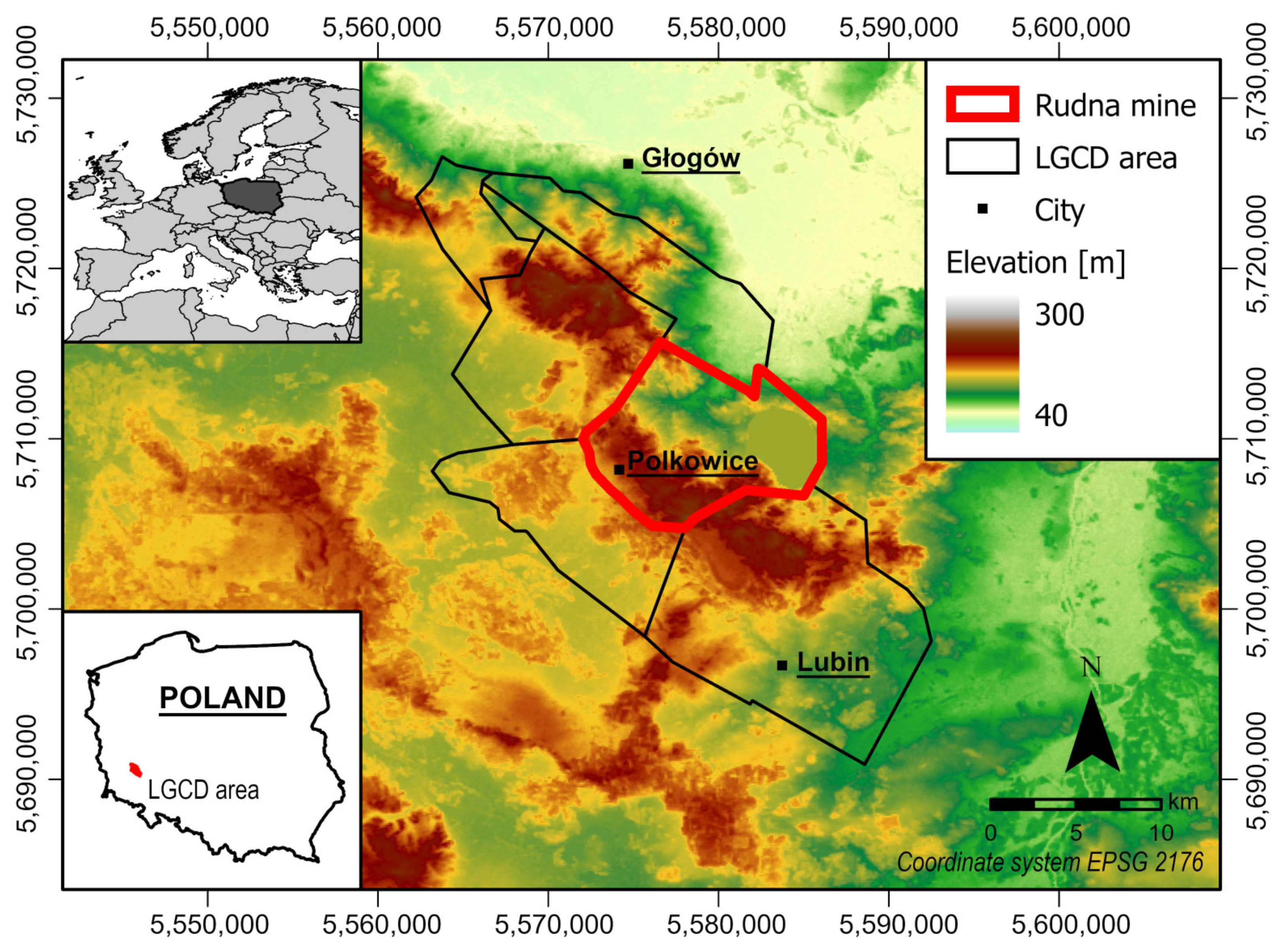
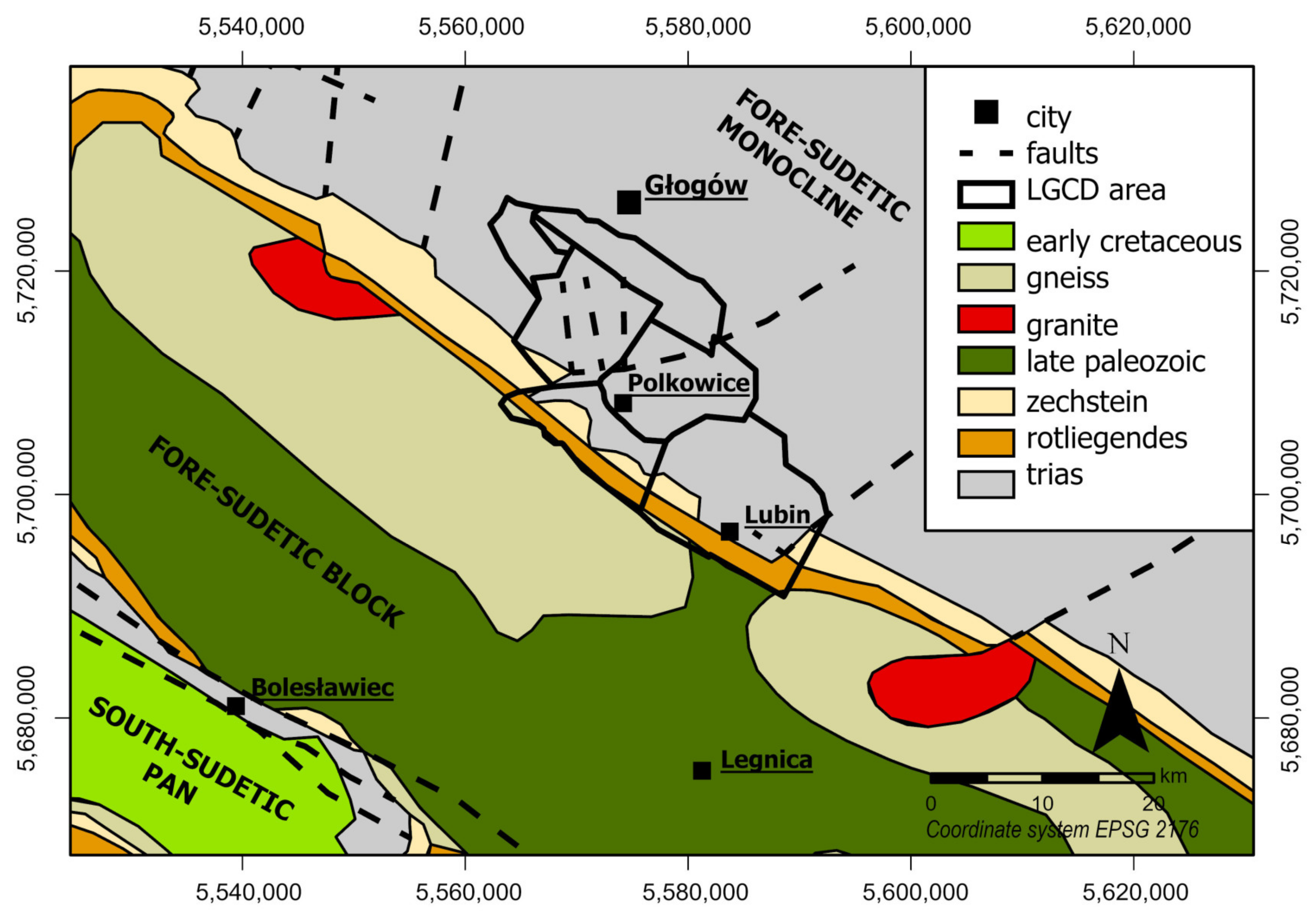
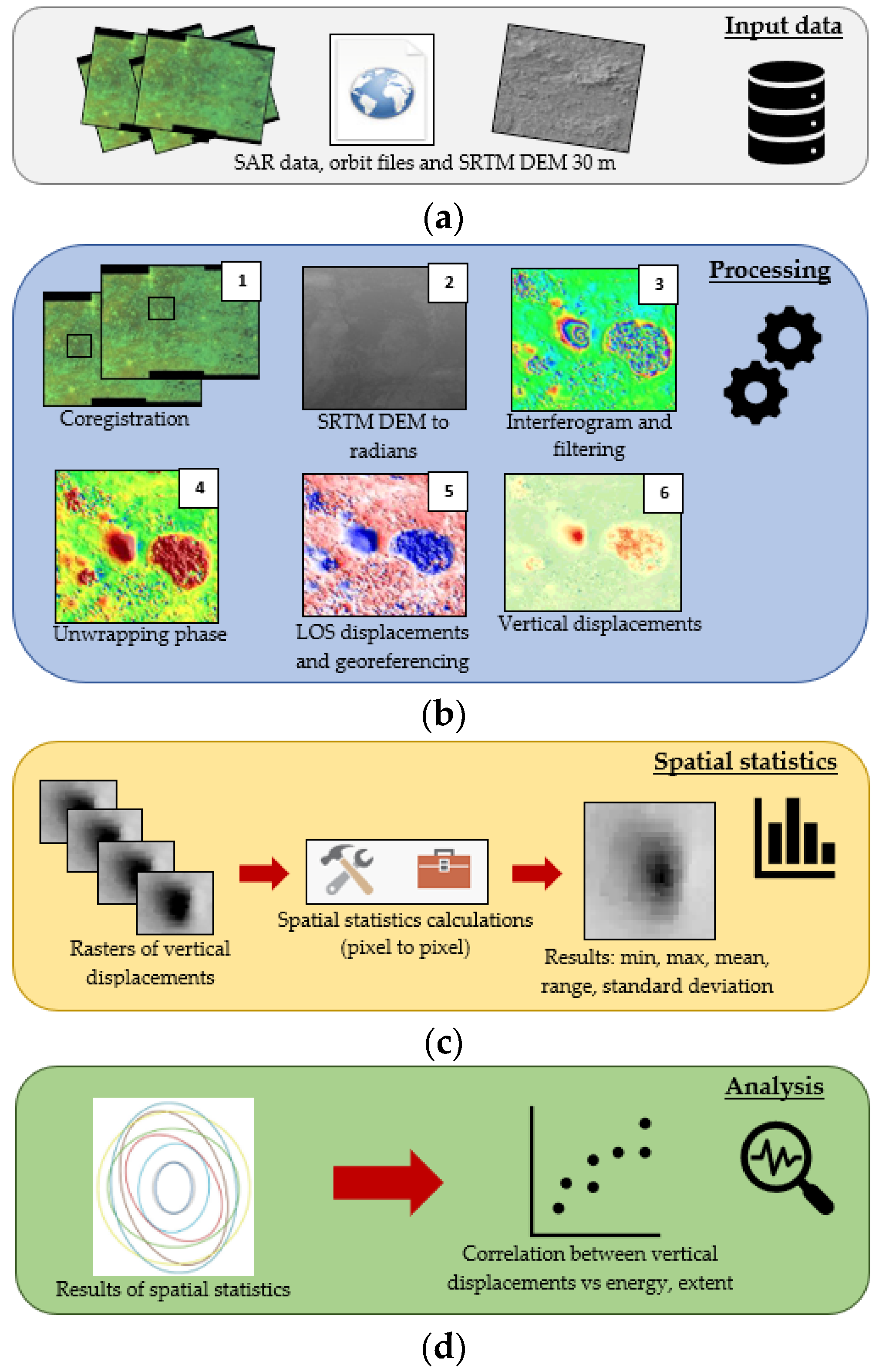
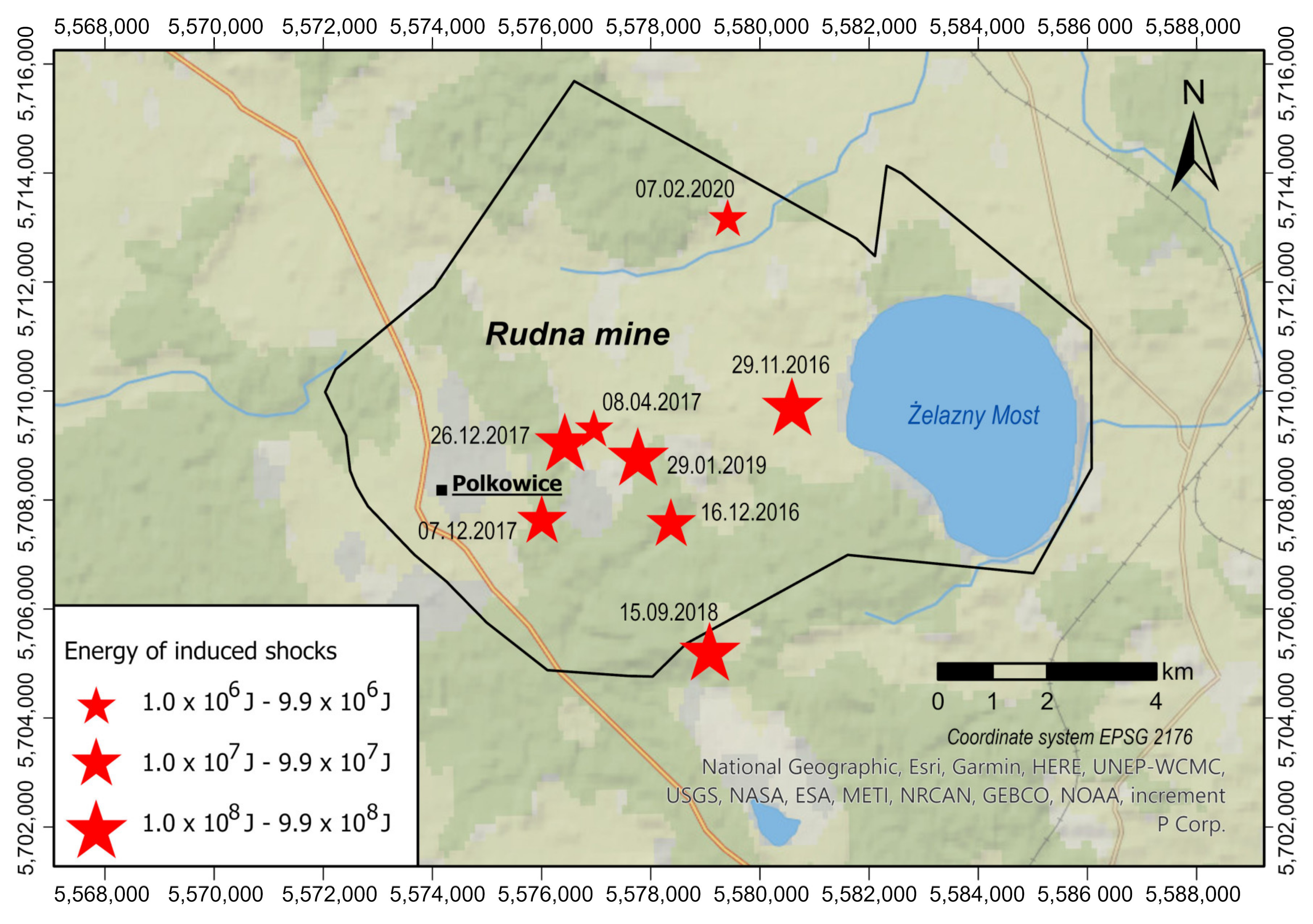
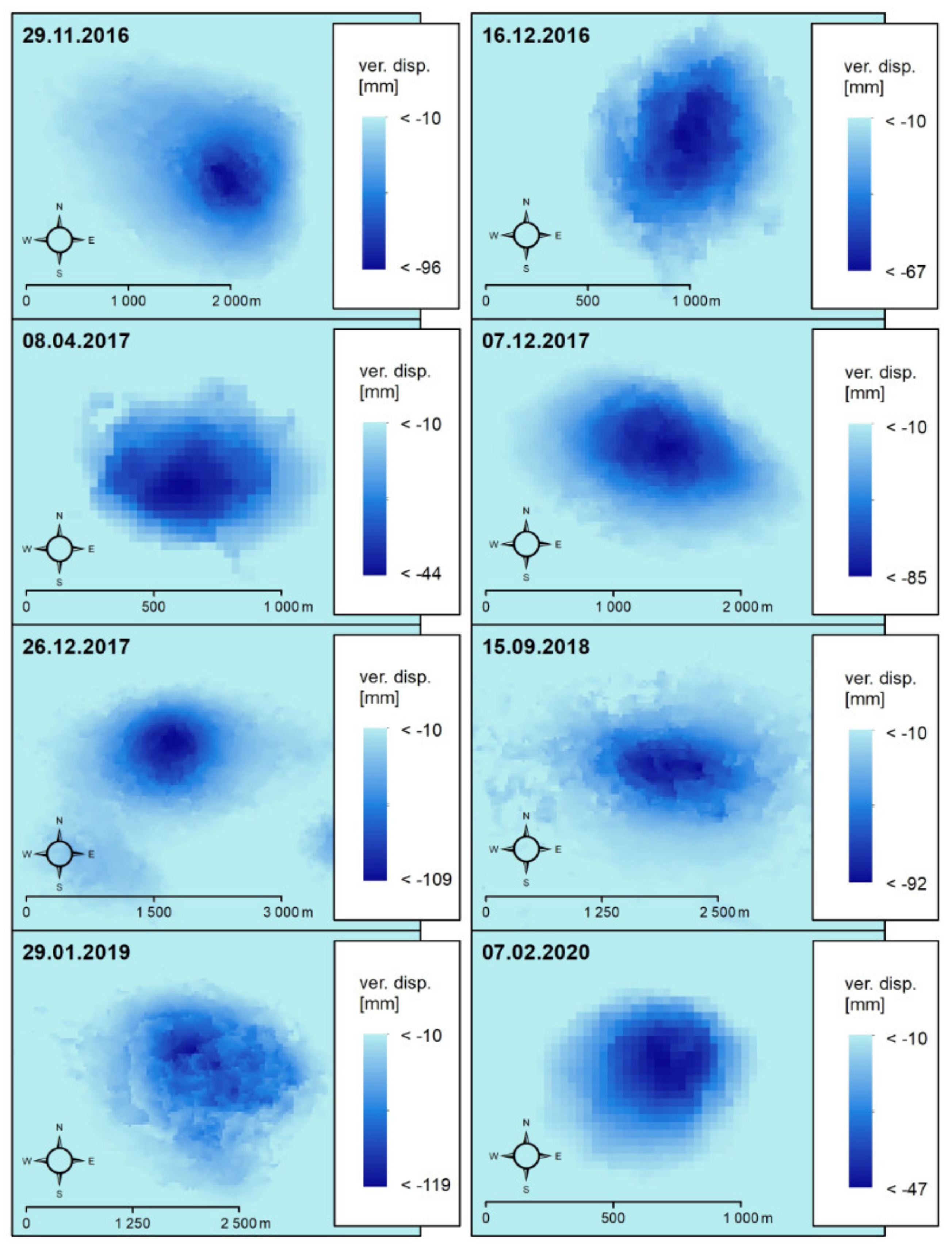
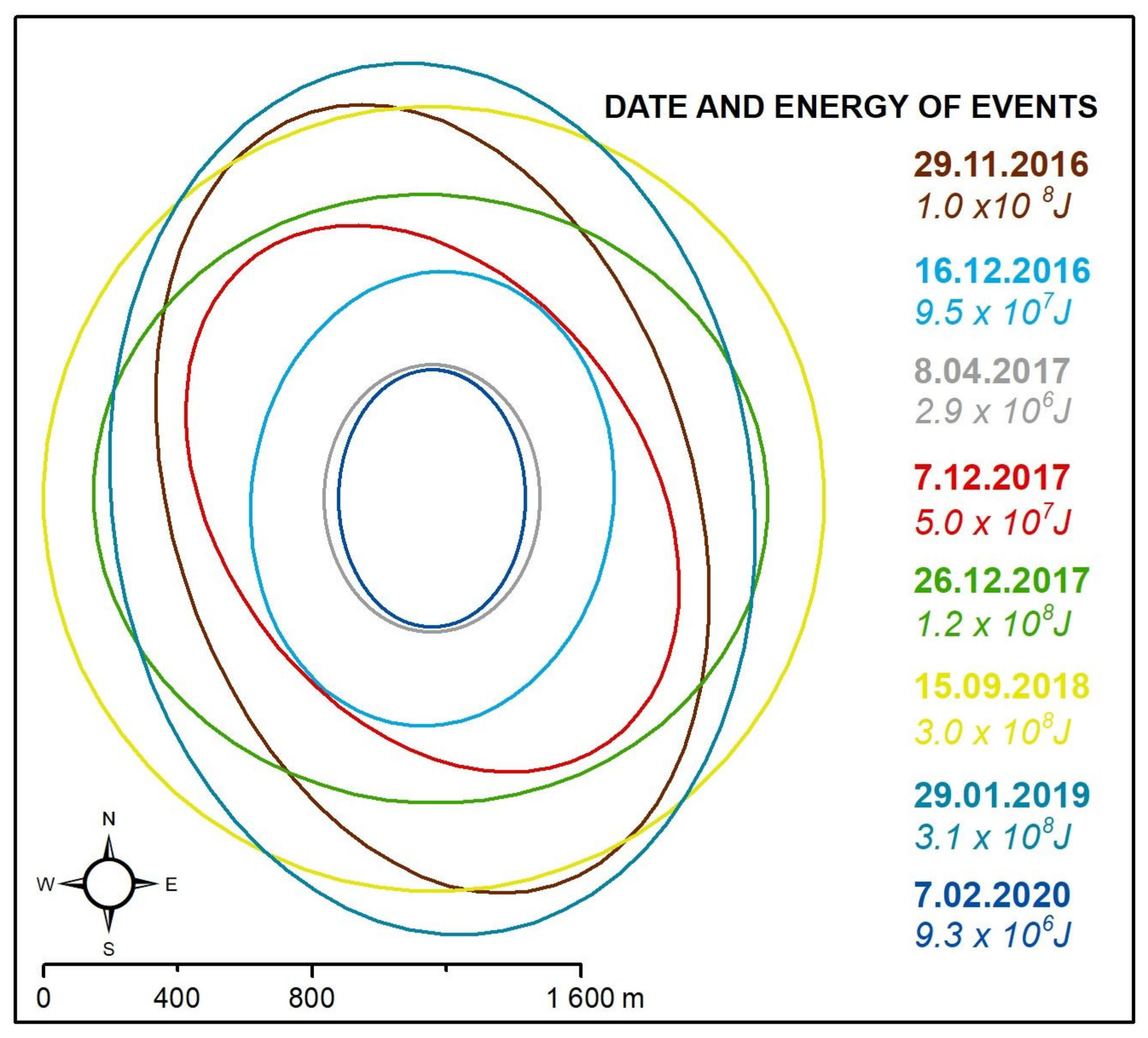
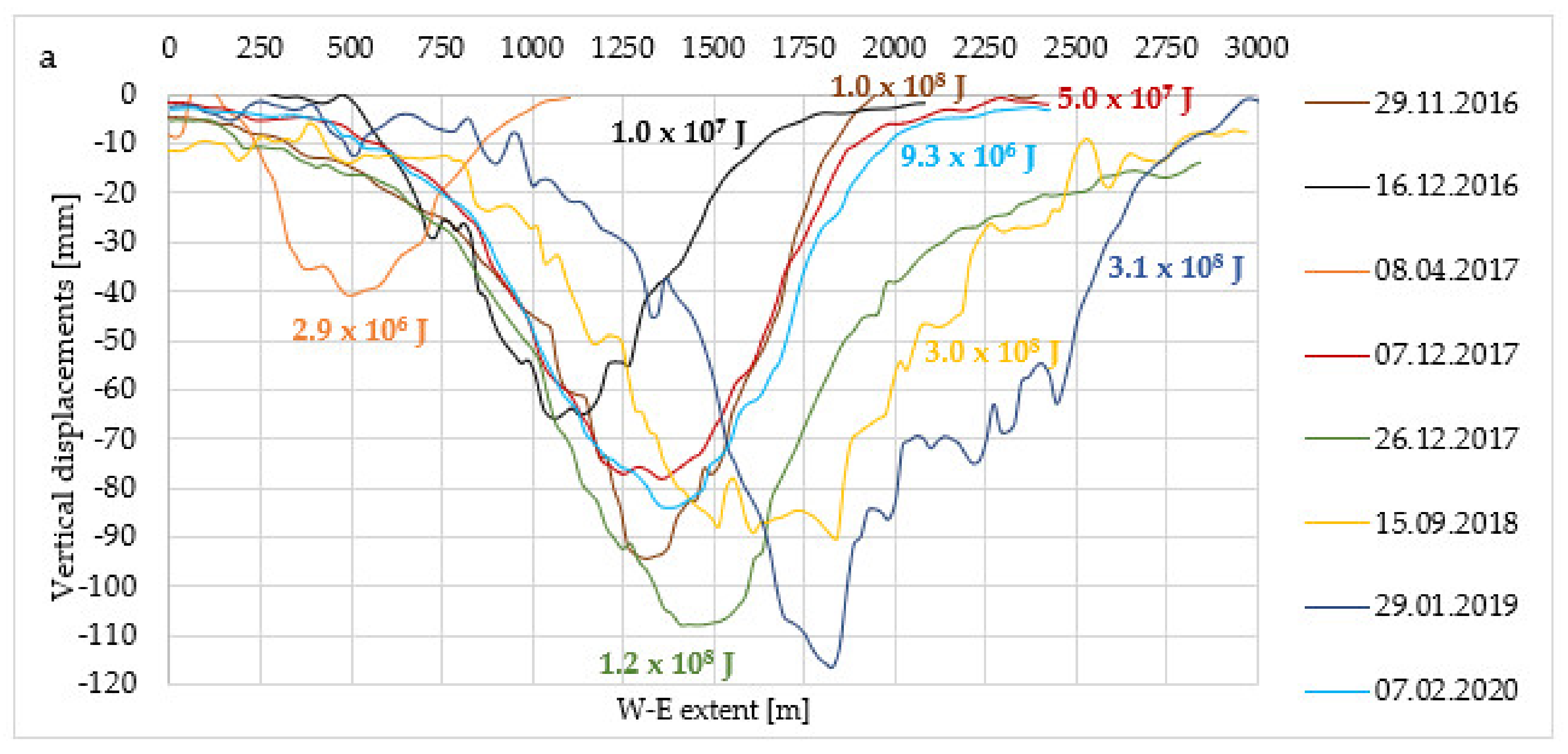
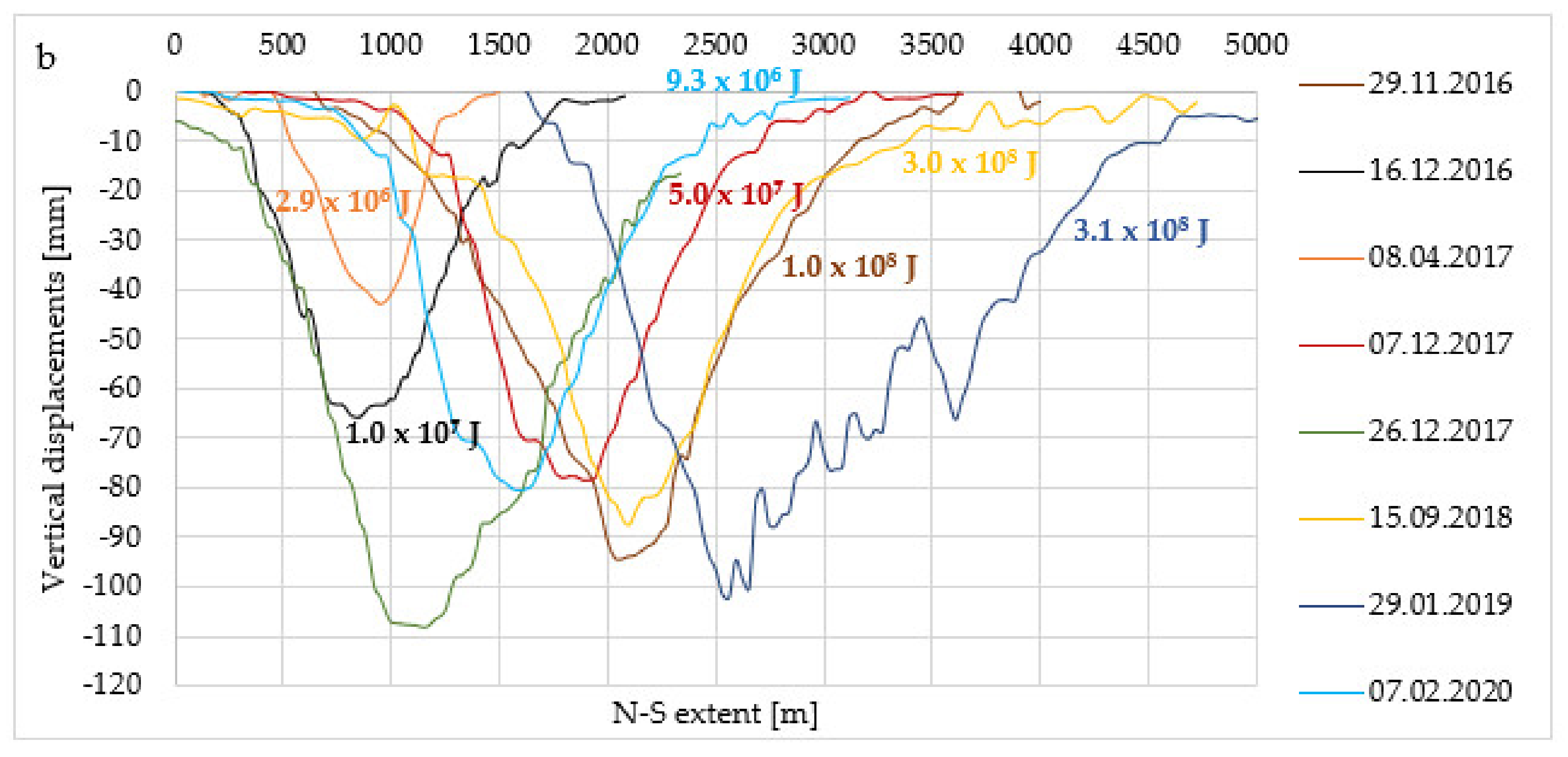
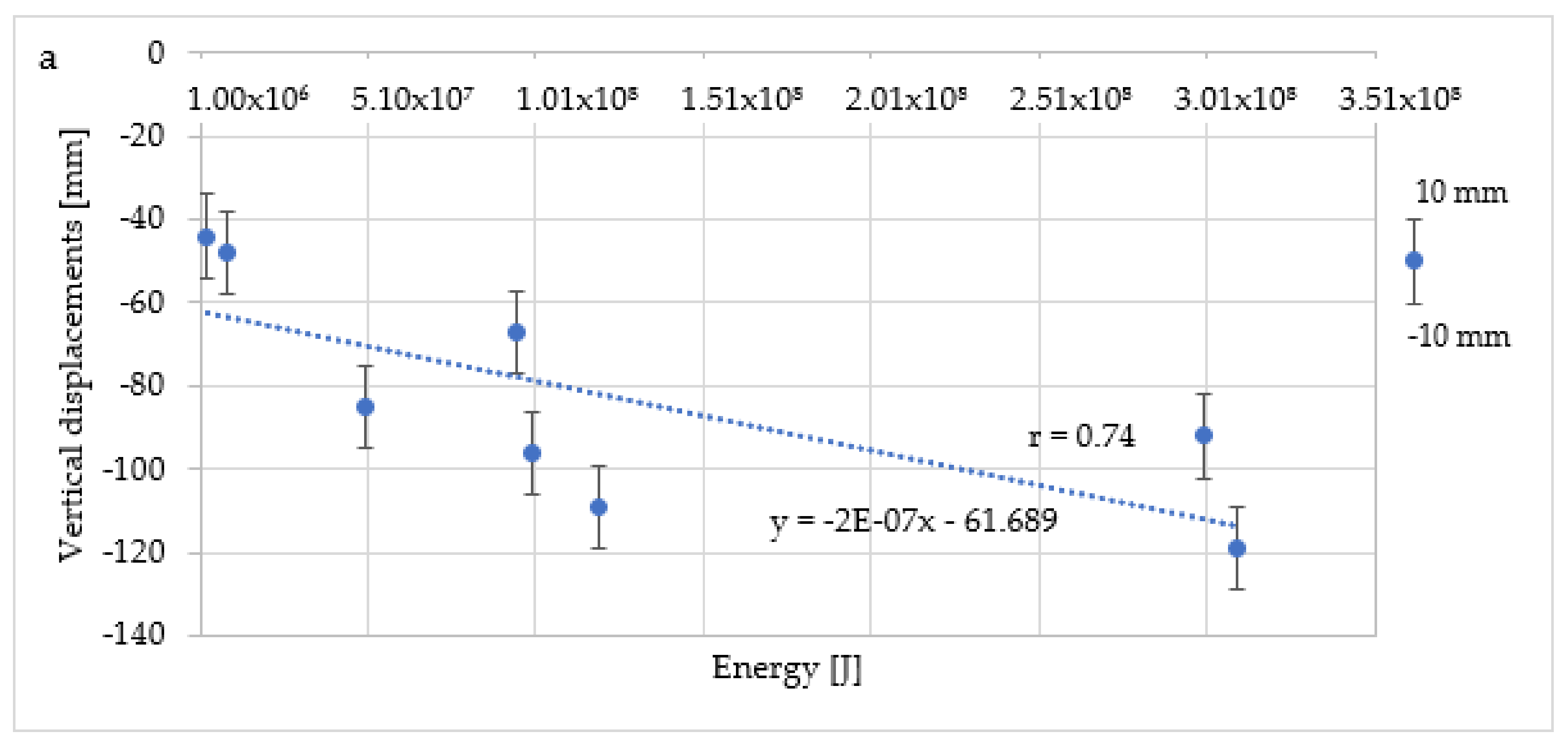
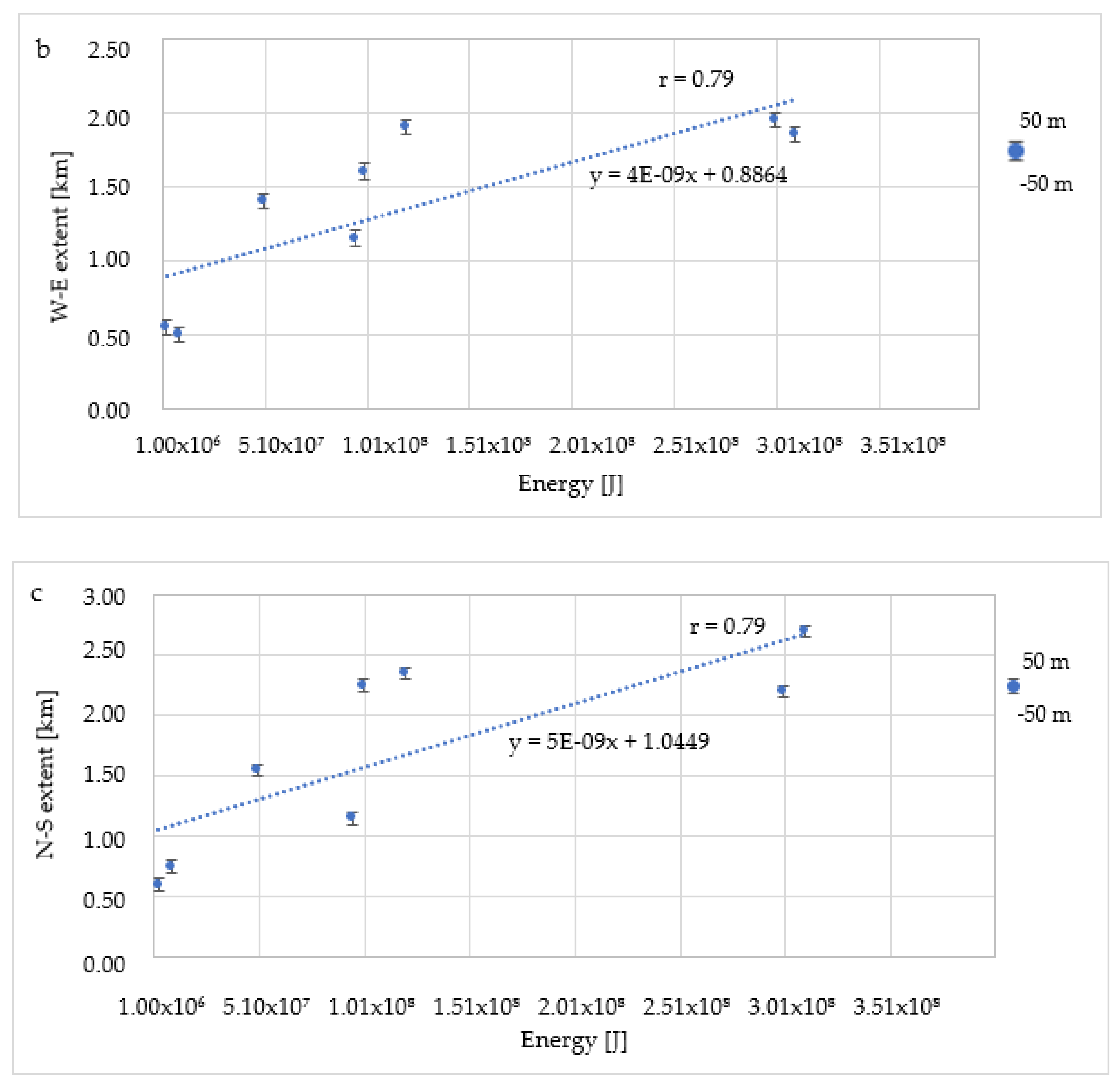
| Authors, Date of Publication | Area of Interest | Date of Analyzed Shocks | Satellites and Methods |
|---|---|---|---|
| Juncu, 2020 [16] | Iceland, near Reykjavik | from 2011 to 2012 | TerraSAR-X satellite, InSAR method |
| Békési et al., 2019 [17] | Mexico, LHGF | from 2003 to 2007 | Envisat satellite, Persistent Scatterer InSAR method |
| Rudziński et al., 2019 [18] | Poland, USCB —Wujek Mine | 17.04.2015, M = 4.0 | Sentinel-1 satellites, InSAR method |
| Milczarek, 2019 [19] | Poland, LGCD —Rudna Mine | from 12.2014 to 05.2018 | Sentinel-1 satellites, Small Baseline Subset (SBAS) method |
| Hejmanowski et al., 2019 [20] | Poland, LGCD—Rudna Mine | 07.12.2017, M = 4.7 26.12.2017, M = 4.8 | Sentinel-1 satellites, DInSAR method |
| Malinowska et al., 2018 [21] | Poland, LGCD—Rudna Mine | 29.11.2016, M = 4.5 | Sentinel-1 satellites, DInSAR method |
| Krawczyk and Grzybek, 2018 [22] | Poland, USCB | from 01.09.2015 to 27.09.2019, M > 2.5 | Sentinel-1 satellites, InSAR method |
| Loesh and Sagan, 2018 [23] | USA, Oklahoma | from 2016 to 2011 | ALOS PALSAR satellite, SBAS method |
| Barnhart et al., 2018 [24] | USA, Oklahoma | 2016, M > 5.0 | Sentinel-1 satellites, InSAR method |
| Kubanek et al., 2018 [25] | Canada, WCSB | from 1992 to 2018, M > 4.0 | satellites: ERS-1/2, Envisat, Sentinel-1; InSAR method |
| Albano et al., 2017 [26] | Botswana | 03.04.2017, M = 6.5 | Setinel-1 satellites, InSAR method |
| Thorpe, 2017 [27] | USA, Oklahoma | 2007-2011, 2014-2017 | satellites: Radarsat-2, Sentinel-1, ALOS PALSAR 1 and 2; DInSAR method and Multidimensional SBAS method |
| Authors, Date of Publication | Area of Interest | Subject of Study | Methods |
|---|---|---|---|
| Blachowski, 2016 [28] | Poland, Wałbrzych | analysis and modelling of mining induced land subsidence | Weighted Spatial Regression method in geographic information systems (GIS) |
| Sedlak, 2015 [29] | Slovakia, Kosice | three-dimensional (3D) deformation vectors | leveling and global positioning system (GPS) measurements, implementation of results into GIS for public administration |
| Malinowska, 2014 [30] | Poland, Upper Silesia | assessment of building damage class in mining areas in changeable exploitation conditions | GIS and a classification and regression theory (CART) |
| Park et al., 2014 [31] | Korea, Samcheok | ground-subsidence hazard indexes and maps | fuzzy ensemble techniques and a GIS |
| Blachowski et al., 2013 [32] | Canada, area of salt, potash and shale gas exploitation | continuous ground displacement field from scattered monitoring surveys in mining areas | map algebra concept, raster analysis and surface interpolation of discrete points with deterministic and geostatistical (kriging) methods |
| Stecchi et al., 2012 [33] | Bosnia Herzegovina, Tuzla | the vulnerability assessment of urban elements over a wide area, potentially affected by deformation phenomena | use of geospatial data and multi-criteria method |
| Oh and Lee, 2010 [34] | Korea, Samcheok | mapping ground subsidence spatial hazard | weights-of-evidence (W–of–E) in GIS |
| Choi et al., 2010 [35] | Korea, Taebaek | coal mine subsidence susceptibility maps | a combination of certainty factor analysis and fuzzy relations with a GIS |
| Esaki et al., 2008 [36] | Japan, Kyushu | prediction method to calculate 3D subsidence | a stochastic model of ground movements and a geographical information system |
| Zahiri et al., 2006 [37] | Australia, Nepean River area | model of rockfall potential associated with mining-induced subsidence | weights-of-evidence (W–of–E), frequency ratio (FR), logistic regression (LR), and an artificial neural network (ANN) in GIS |
| Date of Seismic Event | 29/11/16 | 16/12/16 | 08/04/17 | 07/12/17 | 26/12/17 | 15/09/18 | 29/01/19 | 07/02/20 |
|---|---|---|---|---|---|---|---|---|
| Magnitude 1 | M = 3.50 | M = 3.50 | M = 2.71 | M = 3.34 | M = 3.54 | M = 3.74 | M = 3.75 | M = 2.97 |
| Energy 2 (J) | 1.0 × 108 | 9.5 × 107 | 2.9 × 106 | 5.0 × 107 | 1.2 × 108 | 3.0 × 108 | 3.1 × 108 | 9.3 × 106 |
| Number of correct pairs | 5 | 4 | 4 | 8 | 5 | 3 | 2 | 7 |
| minimum vertical displacements (mm) | −79 | −36 | −37 | −74 | −103 | −81 | −100 | −22 |
| maximum vertical displacements (mm) | −123 | −96 | −58 | −115 | −129 | −111 | −144 | −79 |
| mean vertical displacements (mm) | −96 | −67 | −44 | −85 | −109 | −92 | −119 | −48 |
| minimum W–E extent (m) | 1500 | 850 | 500 | 1250 | 1800 | 1750 | 1700 | 400 |
| maximum W–E extent (m) | 1750 | 1450 | 600 | 1750 | 1950 | 2300 | 1950 | 650 |
| mean W–E extent (m) | 1600 | 1150 | 550 | 1400 | 1900 | 1950 | 1850 | 500 |
| minimum N–S extent (m) | 2000 | 1000 | 550 | 1400 | 1850 | 1900 | 2650 | 500 |
| maximum N–S extent (m) | 2350 | 1250 | 650 | 1900 | 3000 | 2500 | 2750 | 900 |
| mean N–S extent (m) | 2250 | 1150 | 600 | 1550 | 2350 | 2200 | 2700 | 750 |
Publisher’s Note: MDPI stays neutral with regard to jurisdictional claims in published maps and institutional affiliations. |
© 2020 by the authors. Licensee MDPI, Basel, Switzerland. This article is an open access article distributed under the terms and conditions of the Creative Commons Attribution (CC BY) license (http://creativecommons.org/licenses/by/4.0/).
Share and Cite
Owczarz, K.; Blachowski, J. Application of DInSAR and Spatial Statistics Methods in Analysis of Surface Displacements Caused by Induced Tremors. Appl. Sci. 2020, 10, 7660. https://doi.org/10.3390/app10217660
Owczarz K, Blachowski J. Application of DInSAR and Spatial Statistics Methods in Analysis of Surface Displacements Caused by Induced Tremors. Applied Sciences. 2020; 10(21):7660. https://doi.org/10.3390/app10217660
Chicago/Turabian StyleOwczarz, Karolina, and Jan Blachowski. 2020. "Application of DInSAR and Spatial Statistics Methods in Analysis of Surface Displacements Caused by Induced Tremors" Applied Sciences 10, no. 21: 7660. https://doi.org/10.3390/app10217660
APA StyleOwczarz, K., & Blachowski, J. (2020). Application of DInSAR and Spatial Statistics Methods in Analysis of Surface Displacements Caused by Induced Tremors. Applied Sciences, 10(21), 7660. https://doi.org/10.3390/app10217660




